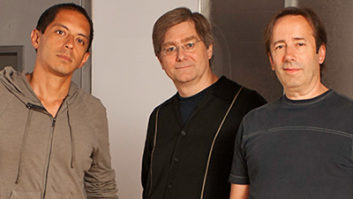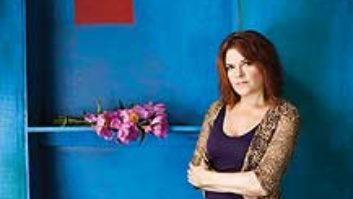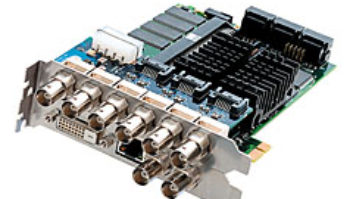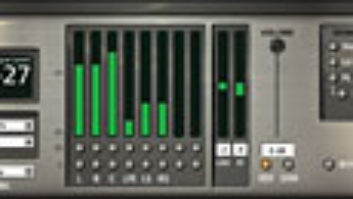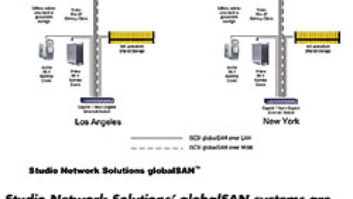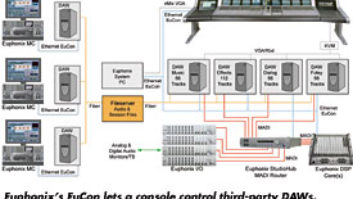New Standard Post is a brash new company that’s making big waves on the Hollywood post-production scene. Designed from the ground up to specialize in work for independent feature films and television, NSP is housed in a four-story, 40,000-square-foot complex on Santa Monica Boulevard, where it’s pushing the envelope of tapeless, paperless production.
The facility’s principal players all have extensive backgrounds in digital media. If they sport a somewhat evangelical attitude, it can be forgiven when you get a glimpse of what they’ve created: an elegantly innovative environment that facilitates working really creatively, really quickly.
As part of the trend toward packaged, one-stop service, NSP offers picture editing, digital visual effects and, of course, full-blown sound. The sound department can handle any type of project through final print mastering, including transfer, sound design, ADR, music, dialog and effects editing, and mix to picture. There is also an extensive custom sound effects library. All departments are linked by a high-speed network, with server-based technology that allows instant access.
The centerpieces of NSP’s sound department are its two mixing stages: Both offer dubbing on three Digidesign Pro Tools/Pro Control systems. Stage A has 300-plus tracks of automated mixing and is THX-certified, with a 7.1 surround environment that can resolve to multiple mix formats including Dolby SR/EX. Stage B offers 200-plus tracks of mix capability and is technologically transparent to Stage A.
The keywords “nonlinear” and “server-based” probably best define NSP, which is equipped with more than 22 Pro Tools systems. Company goals include complete compatibility of sound files, total access to all elements over the high-speed network, and recall of all raw elements. The process that achieves these goals, however, starts at the front door.
“We work in an almost tapeless environment,” explains sound department head Dean Hovey. “When elements arrive, they’re logged in and recorded as computer files, then organized into the network server. From that point, the server functions as the working vault for all elements used on a show. An editor pulls down the needed elements to their computer, and when editing is completed they move the files back to the server for pickup by the next person. There’s no cue time, no moving parts, nothing to wear out or break down. When the project leaves the facility, it can be transferred to whatever medium the client wants, from digital tape to Mo or mag.”
The efficiency of such a system is obvious. Working in a software environment allows editors and mixers the creative freedom to test options in real time with the ability to “undo” if something doesn’t work. Speed aside, most sounds remain first-generation from when they enter the building until the print master.
“Since the Pro Control is just a control surface for the Pro Tools,” says Hovey, “they’re mixing real time on the stage off original elements. There’s no generation loss. And, unlike when you’re using a big analog or digital console, large amounts of converters aren’t needed because all mixing is done inside of the Pro Tools. If you’re using six channels for 5.1 surround, there are only six D-to-A converters in the whole room.”
Most of the rooms at NSP are based around Pro Tools and Sample Cell II systems. Monitoring in the editing suites is set up in 5.1 with JBL LSR Series speaker systems that translate well to the five-across-the-screen JBL system on the mix stages, and editors are encouraged to deliver full 5.1 mixed sessions, complete with pans and perspectives, to the stages.
The designer of NSP’s digital systems is technology strategist Scott Wood, who is charged with ensuring communication between the multiple networks. “We have three criteria for choosing equipment,” he says. “Does it make a time-stamped Sound Designer II file? Does it communicate and file transfer over a standard network? And, does it have total recall?”
The ADR stage is a good example of the paperless environment encouraged at NSP. Its Pro Tools setup uses Gallery’s ADR Studio program to automate cueing, naming, slating and even safety DAT backups. Upon completion, the recorded files are ready to be transferred to the network for access by the dialog editors. The ADR mixer no longer has to document his or her work because the session is automatically saved to the server along with its cue sheet and descriptions.
“In the past, you had to sit in an editing room with a separate database program that printed out what you wanted to do,” Wood explains. “With this system you select a line on the screen, hit one button and it automatically moves the line into the database. It even prints out your spotting sheets. You use the same program to control the ADR stage; inter-action is integrated back and forth with every line separated by character and by reel. There’s a guide track that isolates the line you want to replace, marks it and runs it. But you still have all of the takes of that line available, if you want them. You don’t have to go to transfer to get them, you don’t have to say to an assistant, ‘Would you load in the first five takes because I’d like to see if I can use them?’ They’re already here. Everything is here.”
All of this integration comes together on the dubbing stages. Mixers can open the prepared 5.1 mix an editor has done and continue in that artistic direction, or they can quickly disable the premixes back down to the raw elements to go in a different direction. The re-recording mixers, all of whom have extensive editing experience, are also connected to the network effects library.
The final Pro Tools mixes, which include all sound elements and automation moves, are backed up for use at any time, something that comes in very handy to create versions of the show for different markets. Final stems are also recorded into Pro Tools and backed up along with the rest of the show, so that multiple delivery formats can be made in an instant.
Most equipment for the edit bays and mix stages is housed in a central machine room, making the rooms themselves especially quiet and, again, allowing for flexibility. “Every bay has digital video,” says chief engineer Brian Slack. “But, for instance, if a client walks in with a Beta SP tape, we just patch it from the machine room to whatever bay they want to listen to it in. In the same way, they can lay back things to DA-88, timecode DAT- whatever they want. It’s no longer necessary for us to have those machines in every room. The A stage, for instance, has four 64-voice Pro Tools systems. If that proves not enough, we can patch in more. We can access any of the systems in the building. Ultimately, we can have about 1,200 tracks running on the A stage.
The library at NSP contains approximately 9,000 hours of effects and is housed on its own Web page. “our editors can access the Web page within the company or externally,” says Slack. “our off-site editors also access the sound library over the Web. It’s a very powerful tool. Someone can type in the word ‘dog’ and come up with 200 dog barks. And, unlike a library that’s on a CD, which only one person can access at a time, if you have three sound effects editors working on the same show, they can all get to the sounds they need simultaneously. They can preview, and once they find the sounds they like they can download them directly to their hard drive. There’s no walking down the hall, waiting in line to pull a CD or a tape-it’s very fast. That process continues onto the mix stage. If the producer’s not happy with the dog bark, they just slide right back onto the Web page and look for an-36 other.”
“It’s definitely groundbreaking,” comments Hovey, “and we’re all very excited about the technology. But from the client’s standpoint, we want it all to be invisible. A lot of our success at doing that is due to our staff. We have working here the next generation of mixers, like Kelly Vandever and Patrick Giraudi. They have credits on hundreds of films, but were master editors before they became mixers; they’re comfortable and familiar with the software. The people we hire to work here can’t just have good resumes; they also need to have a rare understanding of technology.”
“But, ultimately, technology is not the goal here,” interjects Wood. “A lot of people see the previous paradigm of how they worked, and they look for new pieces to fit into this paradigm. We do the opposite. We look at the end product and say, ‘What do we need to do to get there?’ We feel that technology should be a slave to the project, the project shouldn’t be a slave to the technology.” Even before its official July ’99 opening, NSP was busy. Projects in have included Wish You Were Dead for New Line Cinema; Drowning Mona for Destination Films; and Just one Night, Labor Pains and Totally Irresponsible for Prosperity Pictures.
“NSP was built with the intention of creating the most cutting-edge post-production facility in the world,” concludes Hovey. “This company’s startup cash reserve was enormous. We didn’t come up with the system we have here to save money-if we had all the money in the world, we’d still work this way. It’s the most artistic, the most efficient and the most effective. We believe this is the best way to get quality.”
